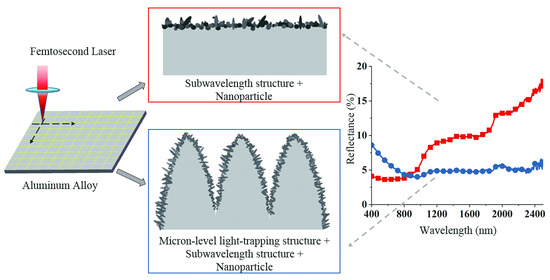Fabrication of Antireflection Micro/Nanostructures on the Surface of Aluminum Alloy by Femtosecond Laser
Abstract
:1. Introduction
2. Experiment and Material
2.1. Material
2.2. Experimental Device
2.3. Machining Parameters
2.4. Characterization
3. Results and Discussions
3.1. Hierarchical Structure
3.2. Antireflection Structure in the Visible Spectral Region: Subwavelength Structure + Nanoparticle
3.3. Antireflection Structure in the Vis-NIR Spectral Region: Microscale Light-Trapping Structure + Subwavelength Structure + Nanoparticle
4. Conclusions
Author Contributions
Funding
Conflicts of Interest
References
- Vorobyev, A.Y.; Guo, C. Direct femtosecond laser surface nano/microstructuring and its applications. Laser Photonics Rev. 2013, 7, 385–407. [Google Scholar] [CrossRef]
- Fan, P.; Zhong, M.; Bai, B.; Jin, G.; Zhang, H. Tuning the optical reflection property of metal surfaces via micro–nano particle structures fabricated by ultrafast laser. Appl. Surf. Sci. 2015, 359, 7–13. [Google Scholar] [CrossRef]
- Hibbins, A.P.; Evans, B.R.; Sambles, J.R. Experimental verification of designer surface plasmons. Science 2005, 308, 670–672. [Google Scholar] [CrossRef] [Green Version]
- Mizuno, K.; Ishii, J.; Kishida, H.; Hayamizu, Y.; Yasuda, S.; Futaba, D.N.; Yumura, M.; Hata, K. A black body absorber from vertically aligned single-walled carbon nanotubes. Proc. Natl. Acad. Sci. USA 2009, 106, 6044–6047. [Google Scholar] [CrossRef] [Green Version]
- Cui, K.; Wardle, B.L. Breakdown of Native Oxide Enables Multifunctional, Free-Form Carbon Nanotube-Metal Hierarchical Architectures. ACS Appl. Mater. Interfaces 2019, 11, 35212–35220. [Google Scholar] [CrossRef] [PubMed]
- Iyengar, V.V.; Nayak, B.K.; Gupta, M.C. Ultralow reflectance metal surfaces by ultrafast laser texturing. Appl. Opt. 2010, 49, 5983–5988. [Google Scholar] [CrossRef]
- Taher, M.A.; Ponnan, S.; Prasad, H.; Rao, D.N.; Naraharisetty, S.R.G. Broadband absorption of nanostructured stainless steel surface fabricated by nanosecond laser irradiation. Nanotechnology 2020, 31, 175301. [Google Scholar] [CrossRef] [PubMed]
- Fan, P.; Zhong, M.; Li, L.; Huang, T.; Zhang, H. Rapid fabrication of surface micro/nano structures with enhanced broadband absorption on Cu by picosecond laser. Opt. Express 2013, 21, 11628–11637. [Google Scholar] [CrossRef] [PubMed]
- Yang, Y.; Yang, J.; Liang, C.; Wang, H. Ultra-broadband enhanced absorption of metal surfaces structured by femtosecond laser pulses. Opt. Express 2008, 16, 11259–11265. [Google Scholar] [CrossRef]
- Fan, P.; Wu, H.; Zhong, M.; Zhang, H.; Bai, B.; Jin, G. Large-scale cauliflower-shaped hierarchical copper nanostructures for efficient photothermal conversion. Nanoscale 2016, 8, 14617–14624. [Google Scholar] [CrossRef]
- Fan, P.; Bai, B.; Long, J.; Jiang, D.; Jin, G.; Zhang, H.; Zhong, M. Broadband High-Performance Infrared Antireflection Nanowires Facilely Grown on Ultrafast Laser Structured Cu Surface. Nano Lett. 2015, 15, 5988–5994. [Google Scholar] [CrossRef]
- Luo, X.; Cai, M.; Liu, W.; Chen, C.; Pan, R.; Zhang, H.; Zhong, M. Flexible control over optical reflection property of metallic surfaces via pulse laser. J. Laser Appl. 2019, 31, 022502. [Google Scholar] [CrossRef]
- Fan, P.; Bai, B.; Zhong, M.; Zhang, H.; Long, J.; Han, J.; Wang, W.; Jin, G. General Strategy toward Dual-Scale-Controlled Metallic Micro-Nano Hybrid Structures with Ultralow Reflectance. ACS Nano 2017, 11, 7401–7408. [Google Scholar] [CrossRef]
- Wang, Y.; Li, C.; Fu, X.; Chang, Y.; Li, S. Research on Coating Aluminum Film’s Reflectance in Visible Spectrum. J. Chang. Univ. Sci. Technol. 2009, 32, 57–59. [Google Scholar]
- Dou, K.; Knobbe, E.T.; Parkhill, R.L.; Irwin, B.; Matthews, L.; Church, K.H. Femtosecond study of surface structure and composition and time-resolved spectroscopy in metals. Appl. Phys. A Mater. Sci. Process. 2003, 76, 303–307. [Google Scholar] [CrossRef]
- Li, T.; Li, X.G.; Dong, C.F.; Cheng, Y.F. Characterization of Atmospheric Corrosion of 2A12 Aluminum Alloy in Tropical Marine Environment. J. Mater. Eng. Perform. 2009, 19, 591–598. [Google Scholar] [CrossRef]
- Fan, P.; Bai, B.; Jin, G.; Zhang, H.; Zhong, M. Patternable fabrication of hyper-hierarchical metal surface structures for ultrabroadband antireflection and self-cleaning. Appl. Surf. Sci. 2018, 457, 991–999. [Google Scholar] [CrossRef]
- Huang, H.; Yang, L.M.; Bai, S.; Liu, J. Blackening of metals using femtosecond fiber laser. Appl. Opt. 2015, 54, 324–333. [Google Scholar] [CrossRef]
- Li, J.; Xu, J.; Lian, Z.; Yu, Z.; Yu, H. Fabrication of antireflection surfaces with superhydrophobic property for titanium alloy by nanosecond laser irradiation. Opt. Laser Technol. 2020, 126, 106129. [Google Scholar] [CrossRef]
- Li, J.R.; Xu, J.K.; Lian, Z.X.; Yu, H.D. Study on Anti-reflection Performance of Titanium Alloy Based on the Change of Repeat Times of Nanosecond Laser Processing. In Proceedings of the International Conference on Manipulation, Manufacturing and Measurement on the Nanoscale (3M-NANO), Zhenjiang, China, 4–8 August 2019; pp. 170–173. [Google Scholar]
- Li, X.; Yuan, C.; Yang, H.; Li, J.; Huang, W.; Tang, D.; Xu, Q. Morphology and composition on Al surface irradiated by femtosecond laser pulses. Appl. Surf. Sci. 2010, 256, 4344–4349. [Google Scholar] [CrossRef]
- Tao, H.; Lin, J.; Hao, Z.; Gao, X.; Song, X.; Sun, C.; Tan, X. Formation of strong light-trapping nano- and microscale structures on a spherical metal surface by femtosecond laser filament. Appl. Phys. Lett. 2012, 100, 201111. [Google Scholar] [CrossRef]
- Vorobyev, A.Y.; Guo, C. Colorizing metals with femtosecond laser pulses. Appl. Phys. Lett. 2008, 92, 041914. [Google Scholar] [CrossRef]
- Leem, J.W.; Song, Y.M.; Lee, Y.T.; Yu, J.S. Effect of etching parameters on antireflection properties of Si subwavelength grating structures for solar cell applications. Appl. Phys. B 2010, 100, 891–896. [Google Scholar] [CrossRef]
- Zheng, B.X.; Wang, W.J.; Jiang, G.D.; Mei, X.S. Fabrication of broadband antireflective black metal surfaces with ultra-light-trapping structures by picosecond laser texturing and chemical fluorination. Appl. Phys. B 2016, 122, 180. [Google Scholar] [CrossRef]
- Chen, M.; Lu, L.; Yu, H.; Li, C.; Zhao, N. Integration of Colloidal Quantum Dots with Photonic Structures for Optoelectronic and Optical Devices. Adv. Sci. 2021, 8, e2101560. [Google Scholar] [CrossRef] [PubMed]
- Degiron, A.; Ebbesen, T.W. The role of localized surface plasmon modes in the enhanced transmission of periodic subwavelength apertures. J. Opt. A Pure Appl. Opt. 2005, 7, S90–S96. [Google Scholar] [CrossRef]
- Koerkamp, K.J.; Enoch, S.; Segerink, F.B.; van Hulst, N.F.; Kuipers, L. Strong influence of hole shape on extraordinary transmission through periodic arrays of subwavelength holes. Phys. Rev. Lett. 2004, 92, 183901. [Google Scholar] [CrossRef] [Green Version]
- Van der Molen, K.L.; Koerkamp, K.J.K.; Enoch, S.; Segerink, F.B.; van Hulst, N.F.; Kuipers, L. Role of shape and localized resonances in extraordinary transmission through periodic arrays of subwavelength holes: Experiment and theory. Phys. Rev. B 2005, 72, 045421. [Google Scholar] [CrossRef] [Green Version]
- Pendry, J.B.; Martin-Moreno, L.; Garcia-Vidal, F.J. Mimicking surface plasmons with structured surfaces. Science 2004, 305, 847–848. [Google Scholar] [CrossRef] [PubMed]
- Wait, J.R. The ancient and modern history of EM ground-wave propagation. IEEE Antennas Propag. Mag. 1998, 40, 7–24. [Google Scholar] [CrossRef]
- Dereux, A.; Ebbesen, T.W.; Barnes, W.L. Surface plasmon subwavelength optics. Nature 2003, 424, 824–830. [Google Scholar]
- Garcia, M.A. Surface plasmons in metallic nanoparticles: Fundamentals and applications. J. Phys. D Appl. Phys. 2011, 44, 283001. [Google Scholar] [CrossRef]
- Raut, H.K.; Ganesh, V.A.; Nair, A.S.; Ramakrishna, S. Anti-reflective coatings: A critical, in-depth review. Energy Environ. Sci. 2011, 4, 3779–3804. [Google Scholar] [CrossRef]
- Sakai, T.; Hirono, M. Laser welding of highly reflective metal with absorbance-enhanced surface structure fabricated using picosecond laser. Appl. Phys. A 2020, 126, 490. [Google Scholar] [CrossRef]
- Zheng, B.; Jiang, G.; Wang, W.; Mei, X.; Wang, F. Surface ablation and threshold determination of AlCu4SiMg aluminum alloy in picosecond pulsed laser micromachining. Opt. Laser Technol. 2017, 94, 267–278. [Google Scholar] [CrossRef]
- Liu, W.; Sun, M.; Guo, Y.; Jiao, Z.; Wu, R.; Pan, X. Ablation characteristics of aluminum alloy and stainless steel induced by picosecond laser pulses. SPIE 2019, 11063, 110631B. [Google Scholar]
- Tao, H.; Lin, J. Enhancing microwave absorption of metals by femtosecond laser induced micro/nano surface structure. Opt. Lasers Eng. 2019, 114, 31–36. [Google Scholar] [CrossRef]

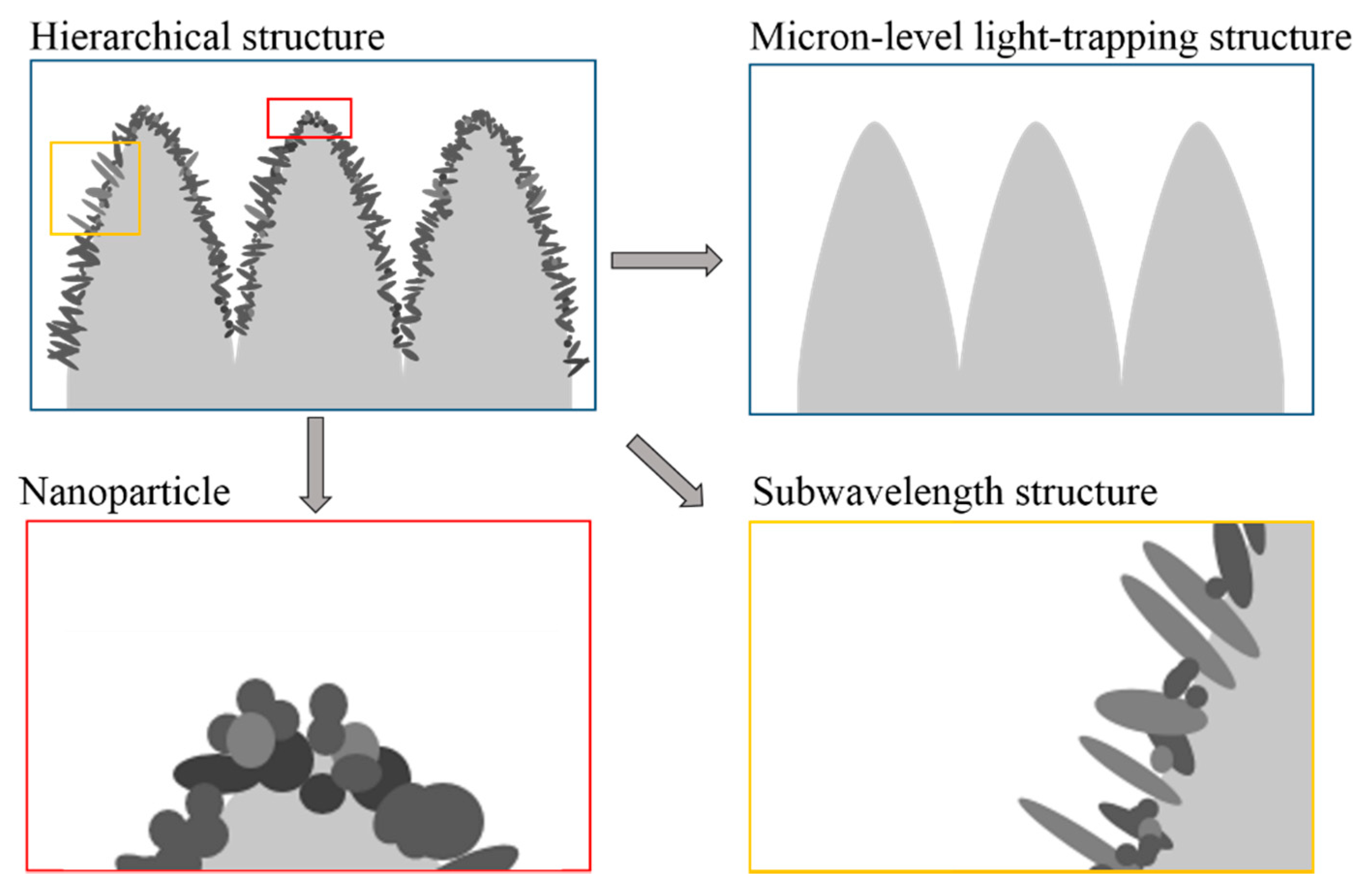


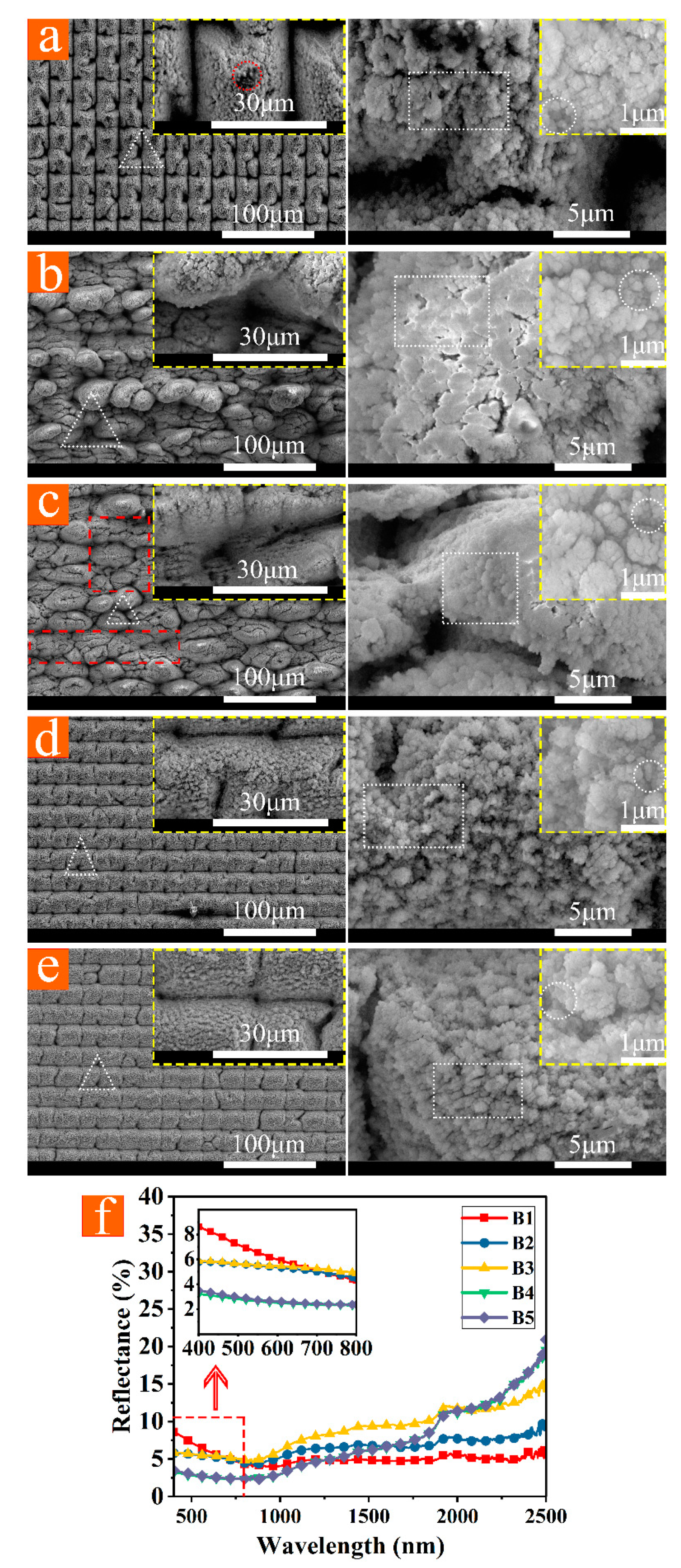
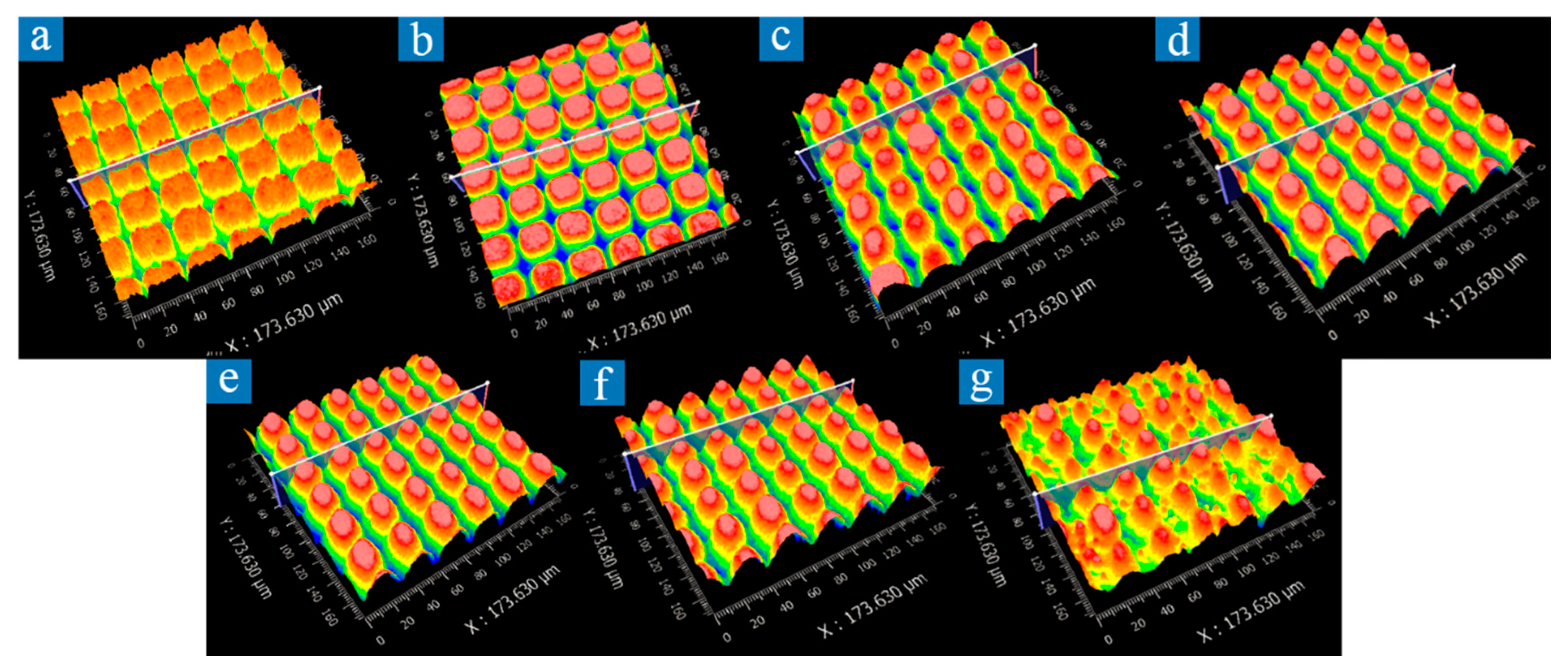
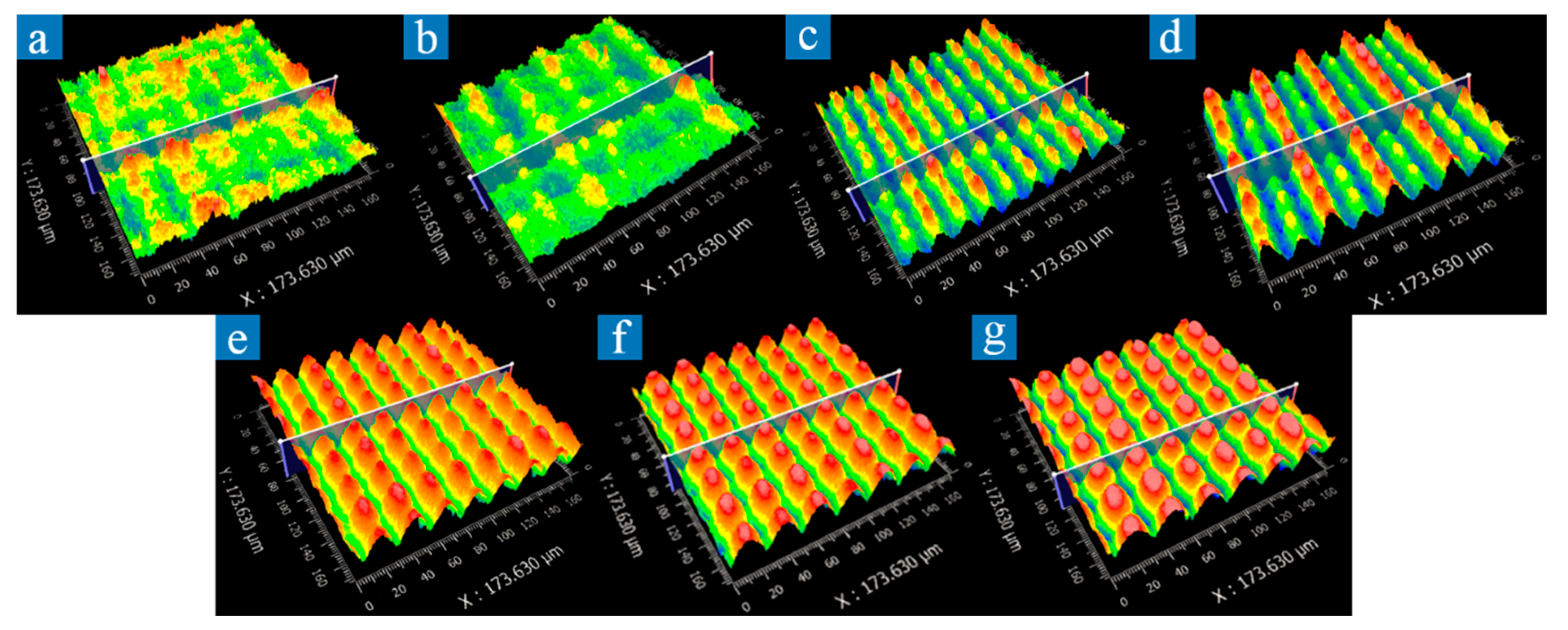
| Al | Si | Fe | Cu | Mn | Mg | Cr | Zn | Ti | Others |
|---|---|---|---|---|---|---|---|---|---|
| ≥92.87 | 0.08 | 0.26 | 4.42 | 0.49 | 1.58 | 0.01 | 0.12 | 0.02 | ≤0.15 |
| Samples | Pulse Energy (μJ) | Power (W) | Fluence (J/cm2) | Velocity (mm/s) | Interval (mm) | Repeat | Defocusing (mm) |
|---|---|---|---|---|---|---|---|
| S1 | 84 | 42 | 18.11 | 20 | 22 | 5 | 4 |
| S2 | 96 | 48 | 20.70 | 10 | 10 | 3 | 3.8 |
| S3 | 84 | 42 | 18.11 | 20 | 10 | 1 | 4.5 |
| B1 | 60 | 30 | 12.94 | 800 | 25 | 80 | 0 |
| 96 | 48 | 20.70 | 30 | 25 | 1 | 4 | |
| B2 | 60 | 30 | 12.94 | 800 | 25 | 100 | 0 |
| 120 | 60 | 25.87 | 25 | 25 | 1 | 4.5 | |
| B3 | 60 | 30 | 12.94 | 800 | 25 | 100 | 0 |
| 120 | 60 | 25.87 | 50 | 25 | 1 | 4.5 | |
| B4 | 62.4 | 31.2 | 13.45 | 800 | 23 | 120 | 0 |
| 84 | 42 | 18.11 | 25 | 23 | 1 | 4 | |
| B5 | 62.4 | 31.2 | 13.45 | 1000 | 22 | 120 | 0 |
| 84 | 42 | 18.11 | 25 | 22 | 1 | 4 |
Publisher’s Note: MDPI stays neutral with regard to jurisdictional claims in published maps and institutional affiliations. |
© 2021 by the authors. Licensee MDPI, Basel, Switzerland. This article is an open access article distributed under the terms and conditions of the Creative Commons Attribution (CC BY) license (https://creativecommons.org/licenses/by/4.0/).
Share and Cite
Du, M.; Sun, Q.; Jiao, W.; Shen, L.; Chen, X.; Xiao, J.; Xu, J. Fabrication of Antireflection Micro/Nanostructures on the Surface of Aluminum Alloy by Femtosecond Laser. Micromachines 2021, 12, 1406. https://doi.org/10.3390/mi12111406
Du M, Sun Q, Jiao W, Shen L, Chen X, Xiao J, Xu J. Fabrication of Antireflection Micro/Nanostructures on the Surface of Aluminum Alloy by Femtosecond Laser. Micromachines. 2021; 12(11):1406. https://doi.org/10.3390/mi12111406
Chicago/Turabian StyleDu, Mengdan, Quanquan Sun, Wei Jiao, Lifeng Shen, Xiao Chen, Junfeng Xiao, and Jianfeng Xu. 2021. "Fabrication of Antireflection Micro/Nanostructures on the Surface of Aluminum Alloy by Femtosecond Laser" Micromachines 12, no. 11: 1406. https://doi.org/10.3390/mi12111406
APA StyleDu, M., Sun, Q., Jiao, W., Shen, L., Chen, X., Xiao, J., & Xu, J. (2021). Fabrication of Antireflection Micro/Nanostructures on the Surface of Aluminum Alloy by Femtosecond Laser. Micromachines, 12(11), 1406. https://doi.org/10.3390/mi12111406





